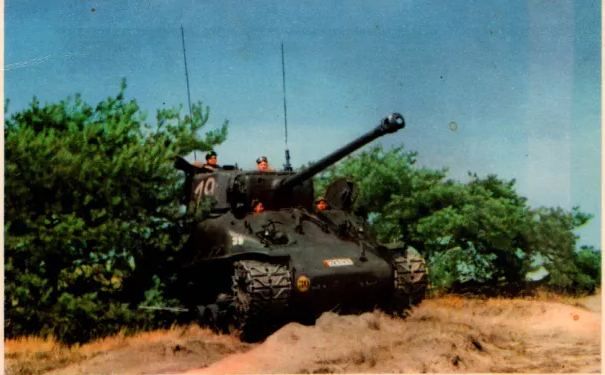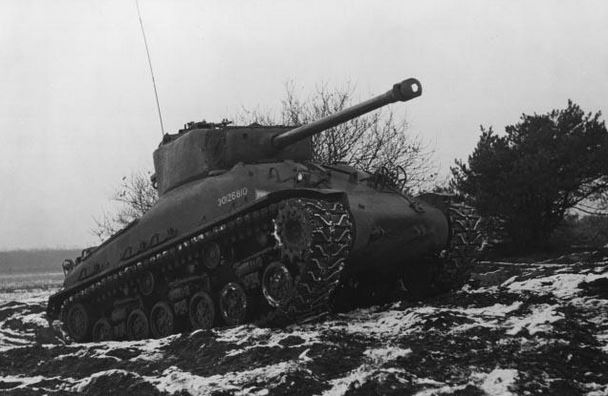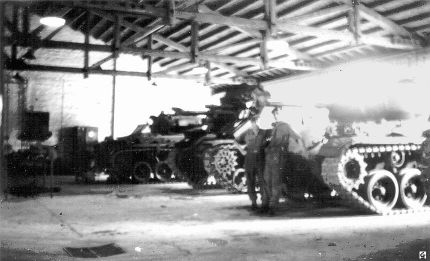- Yes
- No
- (independent) BeNeLux tree
- France: BeNeLux subtree
- other
- no/negative

History
History
The M4A1(76)W HVSS, known informally as the Sherman “Easy Eight”, represented the final and most refined stage of the famous M4 Sherman series. It embodied lessons learned from years of combat across multiple theaters during World War II, while also forming a crucial bridge to the new generation of postwar armored vehicles.
Development and Design Evolution
The M4A1 series traced its roots to the early war M4 Shermans of 1942. Unlike the welded-hull M4 and M4A3, the M4A1 featured a fully cast upper hull, offering improved ballistic deflection and structural integrity. The rounded armor not only provided better protection against incoming projectiles but also simplified manufacturing by eliminating weld seams in critical areas. This design was considered mechanically robust and easier to repair in field conditions, earning the Sherman a reputation for reliability.
Early Shermans carried the short 75 mm M3 gun, which proved increasingly inadequate against late-war German armor. Combat reports from Normandy and Italy prompted a major upgrade: the 76 mm Gun M1 series. This weapon fired high-velocity ammunition with better armor-piercing performance, particularly with HVAP (High Velocity Armor Piercing) rounds. It could penetrate 109 mm of armor at 500 meters — enough to challenge most Axis tanks except the heaviest Panthers and Tigers.
The “W” suffix in the designation indicated wet ammunition stowage, introduced in mid-1944. Earlier Shermans were infamous for “brewing up” when penetrated — ammunition stored in dry racks would ignite easily. Wet stowage solved this by encasing shell bins in water-glycol jackets, drastically reducing fire risk and saving countless crews. This feature became standard in all late-production M4A1 and M4A3 models.
One of the most notable improvements was the Horizontal Volute Spring Suspension (HVSS) system. Introduced in late 1944, it replaced the older VVSS bogies with a wider, smoother setup using horizontally mounted volute springs. The HVSS permitted 23-inch tracks (T66 or T80 type), improving traction, reducing ground pressure, and enhancing ride comfort. This upgrade earned the vehicle its famous nickname — the “Easy Eight.” For crews accustomed to the rough-riding VVSS models, the HVSS was a dramatic improvement in handling, especially across muddy European terrain.
Powering the M4A1 HVSS was the Continental R975 C4 radial engine — a 9-cylinder, air-cooled gasoline powerplant producing 460 horsepower. Originally designed for aircraft, this engine had proven remarkably reliable throughout the war. The engine compartment layout was improved for ease of maintenance, and the transmission featured better cooling and reinforced gears. Combined with the HVSS and strengthened hull, this made the tank smoother, faster, and more reliable than earlier M4s.
Ergonomically, late Shermans featured redesigned turret interiors, improved seating, better optics, and a more efficient turret traverse system. The M62 gun mount allowed for quicker aiming and smoother recoil absorption, and the M47A2 sighting system provided better target visibility under varying light conditions. Crew comfort was modest by modern standards but excellent compared to many wartime contemporaries.
Operational History and U.S. Service
The M4A1(76)W HVSS entered production in late 1944 and saw limited combat before the end of World War II. U.S. armored divisions such as the 2nd and 3rd Armored fielded these tanks during the push into Germany in 1945. They continued in American service postwar, providing a capable, modernized tank during the transition to the Pershing and later Patton series. Many “Easy Eights” later served in Korea, where their mobility and gun power proved useful against T-34-85s.
Postwar Service in Belgium
After liberation, Belgium began rebuilding its army from scratch. Initially reliant on British and Canadian stock, notably the Sherman Firefly and M24 Chaffee. The Belgian Army faced the challenge of modernization within the new NATO structure. With the U.S. Mutual Defense Assistance Program (MDAP), launched in 1949, provided the means to equip Western Europe with standardized American hardware. Under this program, Belgium received roughly 50 M4A1(76)W HVSS tanks around 1950.
In October 1951, the 1st Battalion of Heavy Tanks (1BnZwTnks) was established, becoming Belgium’s first armored unit equipped under NATO doctrine. The 5th Regiment of Lancers, reactivated in 1952, soon joined the armored force, training with Shermans and Chaffees before transitioning into a full tank regiment by 1955. Additional units, including the 2nd and 4th Lancers, operated similar vehicles in reserve and training roles.
Belgian Shermans retained their olive drab paint but carried distinctive identifiers: license plates in the 50xxx range, yellow bridge classification circles marked “30,” and colored geometric unit insignia. These markings helped identify regimental affiliation and platoon within NATO exercises. Tanks were maintained at Arnsberg and other depots in Germany, where Belgian troops trained alongside American and Dutch forces.
Training and Tactical Role
Belgian armored doctrine during the early 1950s emphasized flexibility and combined arms coordination. The M4A1 HVSS was often used in mixed formations with M24 light tanks and half-tracks, focusing on mobility, reconnaissance, and support for infantry divisions. Belgian tankers praised the HVSS Sherman for its smooth handling and mechanical dependability. Many Belgian officers and NCOs trained on these Shermans before transitioning to the M47 Patton and later Leopard 1, forming the core of Belgium’s Cold War armored leadership.
Regular exercises in the Ardennes and West Germany tested logistics and interoperability within NATO forces. Photographs from 1952–1955 show Belgian Shermans maneuvering in dense forest terrain and participating in multinational field trials, especially in preparation for deployment in the Belgian Sector of Germany. These experiences shaped Belgium’s armored doctrine well into the 1960s.
Replacement and Legacy
By the early 1960s, Belgium began replacing its Shermans with the M47 Patton under continued U.S. assistance. Nevertheless, the M4A1 HVSS had already cemented its legacy as the foundation of the reborn Belgian Armored Corps. Many tanks were relegated to training or static defense roles before final retirement. A handful were preserved in museums and memorials, such as those in Bastogne, Leopoldsburg, and Brasschaat, serving as enduring symbols of Belgium’s postwar recovery.
unmodified Belgian M4A1 HVSS turret near the Battle of the Bulge Monument formerly known as the Mardasson Memorial (N49.99452, E5.70543).In design and legacy, the M4A1(76)W HVSS stands as one of the most balanced medium tanks of its generation. Its combination of simplicity, reliability, and incremental innovation kept it relevant for over two decades. For Belgium, it marked the bridge from World War II dependence to Cold War independence — a transitional but vital chapter in both tank design and national defense history.
Specifications
M4A1(76)W HVSS
- Crew: 5
- Dimensions: 7.47 m (hull) / 5.84 m (without gun) × 2.67 m (W) × 2.97 m (H)
- Weight: ~32,000 kg
- Engine: Continental R975 C4, 9-cyl radial, 460 hp @ 2400 rpm
- Power/Weight Ratio: 14.4 hp/t
- Speed: 34 km/h (on/off road)
- Range: 161 km on road
- Fuel Capacity: 796 liters (gasoline)
- Suspension: HVSS (Horizontal Volute Spring Suspension)
- Ground Clearance: 0.43 m
- Gradient: 31°
- Fording Depth: 1 m
- Trench Crossing: 2.3 m
- Vertical Obstacle: 0.61 m
Armament
Main Gun: 76 mm Gun M1A2
- Elevation: -10° to +25°
- Traverse: 360° / 15 sec
- Ammunition Carried: 71 rounds
Secondary Armament:
- 2 × 7.62 mm (.30 cal) M1919A4 MG (coaxial & bow), 6250 rounds
- 1 × 12.7 mm (.50 cal) M2HB AA MG, 600 rounds (rarely used, mounting was mostly used for training on the M47 12.7 mm mounting)
Sights: M47A2
Armour Protection
Hull:
- Front: 51–108 mm @ 34–90°
- Side: 38 mm @ 90°
- Rear: 38 mm @ 70–90°
- Roof/Floor: 25 mm (front), 13 mm (rear)
Superstructure: 64 mm @ 35–53°
Turret:
- Front: 64 mm @ 45–50°
- Side: 64 mm @ 77–90°
- Rear: 64 mm @ 90°
- Mantlet: 89 mm @ 90°
Place in War Thunder
The Belgian M4A1(76)W HVSS would be a solid addition at Rank III–IV, bridging late-WWII Shermans and early Cold War tanks.
- In a BeNeLux tree, as it’s a Belgian vehicle.
- In the French subtree, it would strengthen mid-tier lineups alongside Belgian Fireflies and Chaffees.
- It could also appear as a premium/event vehicle with Belgian markings.
Pictures
Pictures
Belgian M4A1(76)W HVSS on exercise, 1950s
Sources
Sources
- SIPRI Arms Transfers Database – Belgium acquisitions post-WWII
- Nilens, H. (2015). De heroprichting van het Belgische leger na de Tweede Wereldoorlog. VUB
- 2–4L Historical Photos Archive – Historische foto’s 2L – Verbroedering 2/4L
- Wardrawings – Sherman variants – https://www.wardrawings.be/WW2/Files/1-Vehicles/Allies/1-USA/02-MediumTanks/M4-Sherman/File/4-Models(76mm).htm
- Kitmaker forums – Sherman allocations to Belgium – Sherman M4A1 76mm cast hull? - WWII Allied - KitMaker Network
- Sherman Minutia – Sherman minutia homepage
- Tank Sherman M.4 76 mm – 1949-1952 – Armée Belge Belgisch Leger
- Tank Sherman 76 mm – 1949-1952 – Armée Belge Belgisch Leger
- Legacy turrets placed as memorials for the Battle of the Bulge: Tank Turrets of Bastogne - TracesOfWar.com



